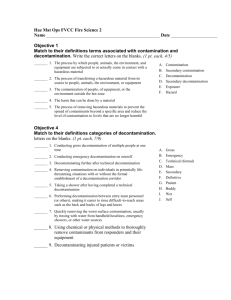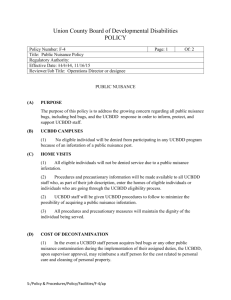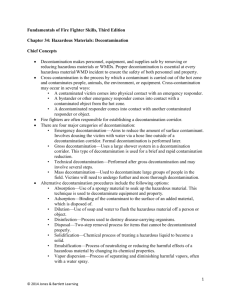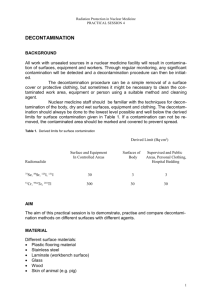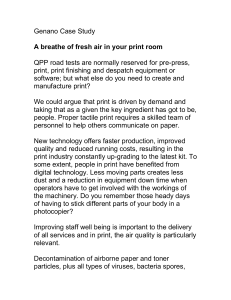CTIF Definitions of Decontamination
advertisement
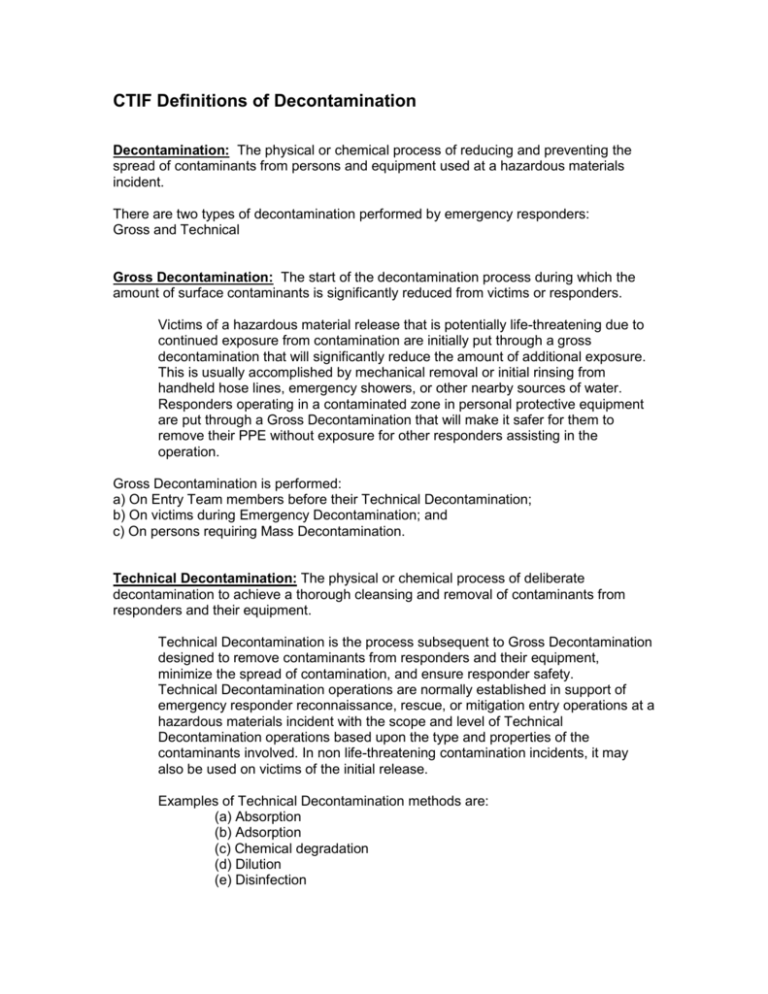
CTIF Definitions of Decontamination Decontamination: The physical or chemical process of reducing and preventing the spread of contaminants from persons and equipment used at a hazardous materials incident. There are two types of decontamination performed by emergency responders: Gross and Technical Gross Decontamination: The start of the decontamination process during which the amount of surface contaminants is significantly reduced from victims or responders. Victims of a hazardous material release that is potentially life-threatening due to continued exposure from contamination are initially put through a gross decontamination that will significantly reduce the amount of additional exposure. This is usually accomplished by mechanical removal or initial rinsing from handheld hose lines, emergency showers, or other nearby sources of water. Responders operating in a contaminated zone in personal protective equipment are put through a Gross Decontamination that will make it safer for them to remove their PPE without exposure for other responders assisting in the operation. Gross Decontamination is performed: a) On Entry Team members before their Technical Decontamination; b) On victims during Emergency Decontamination; and c) On persons requiring Mass Decontamination. Technical Decontamination: The physical or chemical process of deliberate decontamination to achieve a thorough cleansing and removal of contaminants from responders and their equipment. Technical Decontamination is the process subsequent to Gross Decontamination designed to remove contaminants from responders and their equipment, minimize the spread of contamination, and ensure responder safety. Technical Decontamination operations are normally established in support of emergency responder reconnaissance, rescue, or mitigation entry operations at a hazardous materials incident with the scope and level of Technical Decontamination operations based upon the type and properties of the contaminants involved. In non life-threatening contamination incidents, it may also be used on victims of the initial release. Examples of Technical Decontamination methods are: (a) Absorption (b) Adsorption (c) Chemical degradation (d) Dilution (e) Disinfection (f) Evaporation (g) Isolation and Disposal (h) Neutralization (i) Sanitizing (j) Sterilization (k) Solidification (I) Vacuuming (m) Washing Technical Decontamination is performed on Entry Team members. The secondary decontamination sometimes performed on victims in a hospital setting is generally referred to as "Definitive Decontamination". Emergency Decontamination: The physical process of immediately reducing contamination on individuals in potentially life-threatening situations with or without the formal establishment of a decontamination corridor. This can be as simple as removal of outer or all garments from the individuals to washing down with water from a fire hose or emergency safety shower. The sole purpose is to quickly separate as much of the contaminants as possible from the individual to minimize exposure and injury. Mass Decontamination: The physical process of rapidly reducing or removing contaminants from multiple persons (victims and responders) in potentially lifethreatening situations with or without the formal establishment of a decontamination corridor. Mass Decontamination is initiated where the number of victims and time constraints do not allow the establishment of an in-depth decontamination process. It is a Gross Decontamination process utilizing large volumes of lowpressure water to reduce the level of contamination. Ideally, a soap-and-water solution or universal decontamination solution would be more effective, however availability of such solutions in sufficient quantities cannot always be ensured. Extensive research into Mass Decontamination operations at terrorist incidents involving hazardous materials and chemical warfare agents has been conducted by the US Army’s Soldier and Biological Chemical Command (SBCCOM) and the resulting guidelines documents are available through the Internet: Emergency Response, Command, and Planning Guidelines for terrorist incidents involving chemical and biological agents, U.S. Army Soldier and Biological Chemical Command (SBCCOM), http://hld.sbccom.army.mil. Mass Decontamination needs to be established quickly to reduce the harm being done to the victims by the contaminants. Initial operations will likely be the removal of outer clothing and the deluging with water from handheld hose lines or master streams supplied from fire apparatus while a more formal process is being set up. Buddy Decontamination: Decontamination performed with someone as a team to decontaminate each other. It is easier and allows for a more thorough rinsing of places that are difficult to reach such as back, buttocks, and the back of the legs and knees. Self Decontamination: Decontamination performed on oneself in an emergency situation. Usually done by rinsing with a hose line or a blotting/absorption method.

